Mechanical Characterization and Structural Analysis of Latex-Containing and Latex-Free Intermaxillary Orthodontic Elastics
Abstract
1. Introduction
2. Materials and Methods
2.1. Structure of the Study
2.2. Materials and Specimens
- Smile safari (Ortho Organizers, Inc., Carlsbad, CA, USA).
- Leone (Leone S.p.A., Firenze, Italy).
- AO (American Orthodontics, Sheboygan, WI, USA).
- Ormco (Ormco Corporation, Glendora, CA, USA).
- Dentaurum (75228 Ispringen, Germany).
- RMO (Rocky Mountain Orthodontics, Denver, CO, USA).
2.3. Material Testing
2.3.1. Tensile Test
2.3.2. Cyclical Tensile Fatigue Test
2.3.3. 24 h Tension Relaxation
2.3.4. Scanning Electron Microscopy
2.3.5. Raman Spectroscopy Measurements
2.3.6. Statistical Analysis
3. Results
3.1. Tensile Test
3.2. Cyclical Tensile Fatigue Test and Stress Relaxation
3.3. Scanning Electron Microscopy
3.4. Raman Spectroscopy
4. Discussion
5. Conclusions
Supplementary Materials
Author Contributions
Funding
Institutional Review Board Statement
Informed Consent Statement
Data Availability Statement
Acknowledgments
Conflicts of Interest
References
- Janson, G.; Sathler, R.; Fernandes, T.; Zanda, M.; Pinzan, A. Class II malocclusion occlusal severity description. J. Appl. Oral Sci. 2010, 18, 397–402. [Google Scholar] [CrossRef] [PubMed][Green Version]
- Graber, T. The “three M’s”: Muscles, malformation, and malocclusion. Am. J. Orthod. 1963, 49, 418–450. [Google Scholar] [CrossRef]
- Proffit, W.R.; Fields, H.W.; Moray, L.J. Prevalence of malocclusion and orthodontic treatment need in the United States: Estimates from the NHANES III survey. Int. J. Adult Orthod. Orthognath. Surg. 1998, 13, 97–106. [Google Scholar]
- Fernandez, C.C.A.; Pereira, C.V.C.A.; Ferreira, F.F.C.F.; MacIel, J.V.B.; Modesto, A.; Costa, M.C.; Vieira, A.R. IRF6, MSX1, TGFA, Dental Anomalies, and Skeletal Malocclusion. Eur. J. Orthod. 2020, 43, 478–485. [Google Scholar] [CrossRef] [PubMed]
- Lin, Y.; Lin, Y.; Fang, F.; Chen, X.; He, T. The Effect of Orthodontic Treatment on Temporomandibular Joint Morphology in Adult Skeletal Class II Deep Overbite Patients. Am. J. Transl. Res. 2021, 13, 9070–9075. [Google Scholar] [PubMed]
- Santori, F.; Masedu, F.; Ciavarella, D.; Staderini, E.; Chimenti, C.; Tepedino, M. Effect of Class II Functional Treatment on Facial Attractiveness, as Perceived by Professionals and Laypeople. Sci. Rep. 2021, 11, 13989. [Google Scholar] [CrossRef]
- Joshi, N.; Joshi, N.; Hamdan, A.M.; Fakhouri, W.D. Skeletal Malocclusion: A Developmental Disorder With a Life-Long Morbidity. J. Clin. Med. Res. 2014, 6, 399–408. [Google Scholar] [CrossRef]
- Weiland, F.J.; Ingervall, B.; Bantleon, H.P.; Droacht, H. Initial Effects of Treatment of Class II Malocclusion with the Herren Activator, Activator-Headgear Combination, and Jasper Jumper. Am. J. Orthod. Dentofac. Orthop. 1997, 112, 19–27. [Google Scholar] [CrossRef]
- Filho, J.C.B.L.; Gallo, D.B.; Santana, R.M.; Guariza-Filho, O.; Camargo, E.S.; Tanaka, O.M. Influence of different beverages on the force degradation of intermaxillary elastics: An in vitro study. J. Appl. Oral Sci. 2013, 21, 145–149. [Google Scholar] [CrossRef] [PubMed][Green Version]
- Jena, A.K.; Duggal, R.; Parkash, H. Skeletal and dentoalveolar effects of Twin-block and bionator appliances in the treatment of Class II malocclusion: A comparative study. Am. J. Orthod. Dentofac. Orthop. 2006, 130, 594–602. [Google Scholar] [CrossRef]
- Dos Santos, R.L.; Pithon, M.M.; Mendes, G.D.S.; Romanos, M.T.V.; Ruellas, A.C.D.O. Cytotoxicity of intermaxillary orthodontic elastics of different colors: An in vitro study. J. Appl. Oral Sci. 2009, 17, 326–329. [Google Scholar] [CrossRef] [PubMed]
- Sambataro, S.; Bocchieri, S.; Bafumi, L.; Fiorillo, L.; Cervino, G.; Cicciù, M. Elastics Selector Gauge as Orthodontics Device Applied to Inter-Maxillary Traction during Malocclusion Correction. J. Funct. Morphol. Kinesiol. 2019, 4, 63. [Google Scholar] [CrossRef] [PubMed]
- Stevenson, J.S.; Kusy, R.P. Force application and decay characteristics of untreated and treated polyurethane elastomeric chains. Angle Orthod. 1994, 64, 371–376. [Google Scholar] [CrossRef]
- Vieira, C.I.V.; de Oliveira, C.B.; Ribeiro, A.A.; Caldas, S.G.F.R.; Martins, L.P.; Gandini, L.G., Jr.; dos Santos-Pinto, A. In vitro comparison of the force degradation of orthodontic intraoral elastics from different compositions. RSBO 2014, 10, 40–48. [Google Scholar] [CrossRef]
- Klabunde, R.; Grünheid, T. Dynamic Force Decay Evaluation of Latex and Non-Latex Orthodontic Elastics. J. Orofac. Orthop. 2021, 83, 318–324. [Google Scholar] [CrossRef]
- Wang, T.; Zhou, G.; Tan, X.; Dong, Y. Evaluation of Force Degradation Characteristics of Orthodontic Latex Elastics in Vitro and In Vivo. Angle Orthod. 2007, 77, 688–693. [Google Scholar] [CrossRef]
- Hain, M.A.; Longman, L.P.; Field, E.A.; Harrison, J.E. Natural rubber latex allergy: Implications for the orthodontist. J. Orthod. 2007, 34, 6–11. [Google Scholar] [CrossRef]
- Kersey, M.L.; Glover, K.; Heo, G.; Raboud, D.; Major, P.W. An in vitro comparison of 4 brands of nonlatex orthodontic elastics. Am. J. Orthod. Dentofac. Orthop. 2003, 123, 401–407. [Google Scholar] [CrossRef]
- Farjood, A.; Ajami, S.; Zare, M. Synergic effect of salivary pH baselines and low pH intakes on the force relaxation of orthodontic latex elastics. Dent. Res. J. 2017, 14, 68–72. [Google Scholar] [CrossRef]
- Lacerda dos Santos, R.; Pithon, M.M.; Romanos, M.T.V. The influence of pH levels on mechanical and biological properties of nonlatex and latex elastics. Angle Orthod. 2011, 82, 709–714. [Google Scholar] [CrossRef] [PubMed]
- López, N.; Vicente, A.; Bravo, L.A.; Guirado, J.L.C.; Canteras, M. In vitro study of force decay of latex and non-latex orthodontic elastics. Eur. J. Orthod. 2011, 34, 202–207. [Google Scholar] [CrossRef] [PubMed][Green Version]
- Kumar, S.P.; Keerthi, C.N. Assessment of the Force Decay and the Influence of PH Levels on Three Different Brands of Latex and Non-Latex Orthodontic Elastics: An in Vitro Study. Int. J. Appl. Dent. Sci. 2016, 2, 28–34. [Google Scholar]
- Russell, K.; Milne, A.; Khanna, R.; Lee, J. In vitro assessment of the mechanical properties of latex and non-latex orthodontic elastics. Am. J. Orthod. Dentofac. Orthop. 2001, 120, 36–44. [Google Scholar] [CrossRef] [PubMed]
- William, R.P.; Henry, W.F., Jr.; David, M.S. Contemporary Orthodontics, 4th ed.; Mosby Elsevier: St. Louis, MO, USA, 2007. [Google Scholar]
- Loganathan, S.; Santhanakrishnan, S.; Bathe, R.; Arunachalam, M. FTIR and Raman as a noninvasive probe for predicting the femtosecond laser ablation profile on heterogeneous human teeth. J. Mech. Behav. Biomed. Mater. 2020, 115, 104256. [Google Scholar] [CrossRef]
- Larkin, P. Infrared and Raman Spectroscopy: Principles and Spectral Interpretation; Elsevier: Amsterdam, The Netherland, 2011. [Google Scholar] [CrossRef]
- ISO 37:2011; Rubber, Vulcanized or Thermoplastic—Determination of Tensile Stress-Strain Properties. ISO: Geneva, Switzerland, 2011. Available online: https://www.iso.org/standard/53023.html (accessed on 11 October 2022).
- Samran, J.; Phinyocheep, P.; Daniel, P.; Derouet, D.; Buzare, J.-Y. Spectroscopic Study of Di-Imide Hydrogenation of Natural Rubber. Macromol. Symp. 2004, 216, 131–144. [Google Scholar] [CrossRef]
- Cornell, S.W.; Koenig, J.L. The Raman Spectra of Polybutadiene Rubbers. Macromolecules 1969, 2, 540–545. [Google Scholar] [CrossRef]
- Prasertsri, S.; Lagarde, F.; Rattanasom, N.; Sirisinha, C.; Daniel, P. Raman spectroscopy and thermal analysis of gum and silica-filled NR/SBR blends prepared from latex system. Polym. Test. 2013, 32, 852–861. [Google Scholar] [CrossRef]
- Berthelot, K.; Lecomte, S.; Estevez, Y.; Zhendre, V.; Henry, S.; Thévenot, J.; Dufourc, E.J.; Alves, I.D.; Peruch, F. Rubber particle proteins, HbREF and HbSRPP, show different interactions with model membranes. Biochim. Biophys. Acta 2014, 1838, 287–299. [Google Scholar] [CrossRef]
- Kersey, M.L.; E Glover, K.; Heo, G.; Raboud, D.; Major, P.W. A comparison of dynamic and static testing of latex and nonlatex orthodontic elastics. Angle Orthod. 2003, 73, 181–186. [Google Scholar]
- Hwang, C.-J.; Cha, J.-Y. Mechanical and biological comparison of latex and silicone rubber bands. Am. J. Orthod. Dentofac. Orthop. 2003, 124, 379–386. [Google Scholar] [CrossRef]
- Oliveira, P.L.E.; Matsumoto, M.A.N.; Faria, G.; Romano, F.L. Degradation and deformation of latex and non-latex orthodontic elastics. Australas. Orthod. J. 2017, 33, 64–72. [Google Scholar] [CrossRef]
- Liu, C.; Wataha, J.; Craig, R. The effect of repeated stretching on the force decay and compluance of vulcanized cis-polyisoprene orthodontic elastics. Dent. Mater. 1993, 9, 37–40. [Google Scholar] [CrossRef]
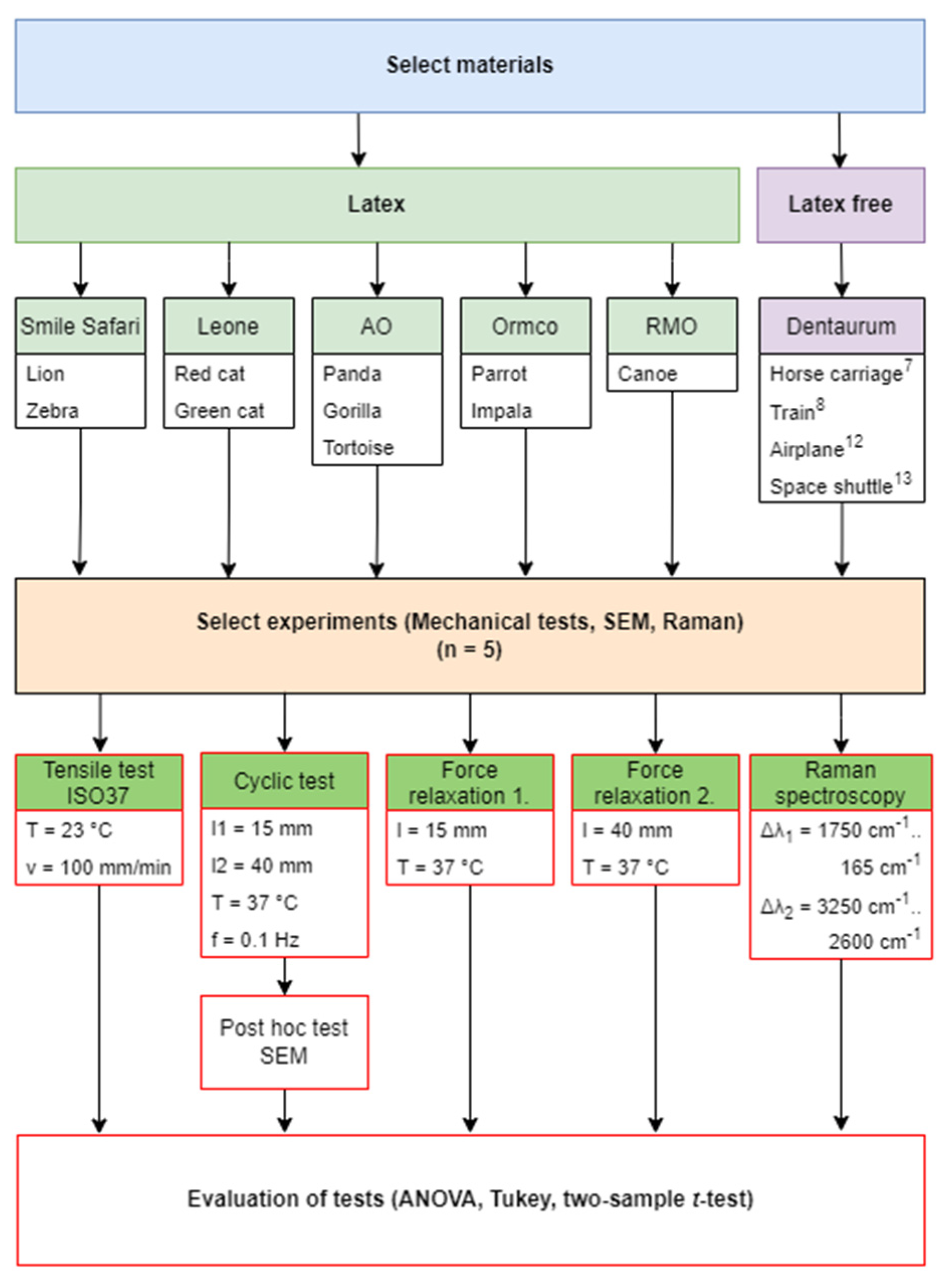
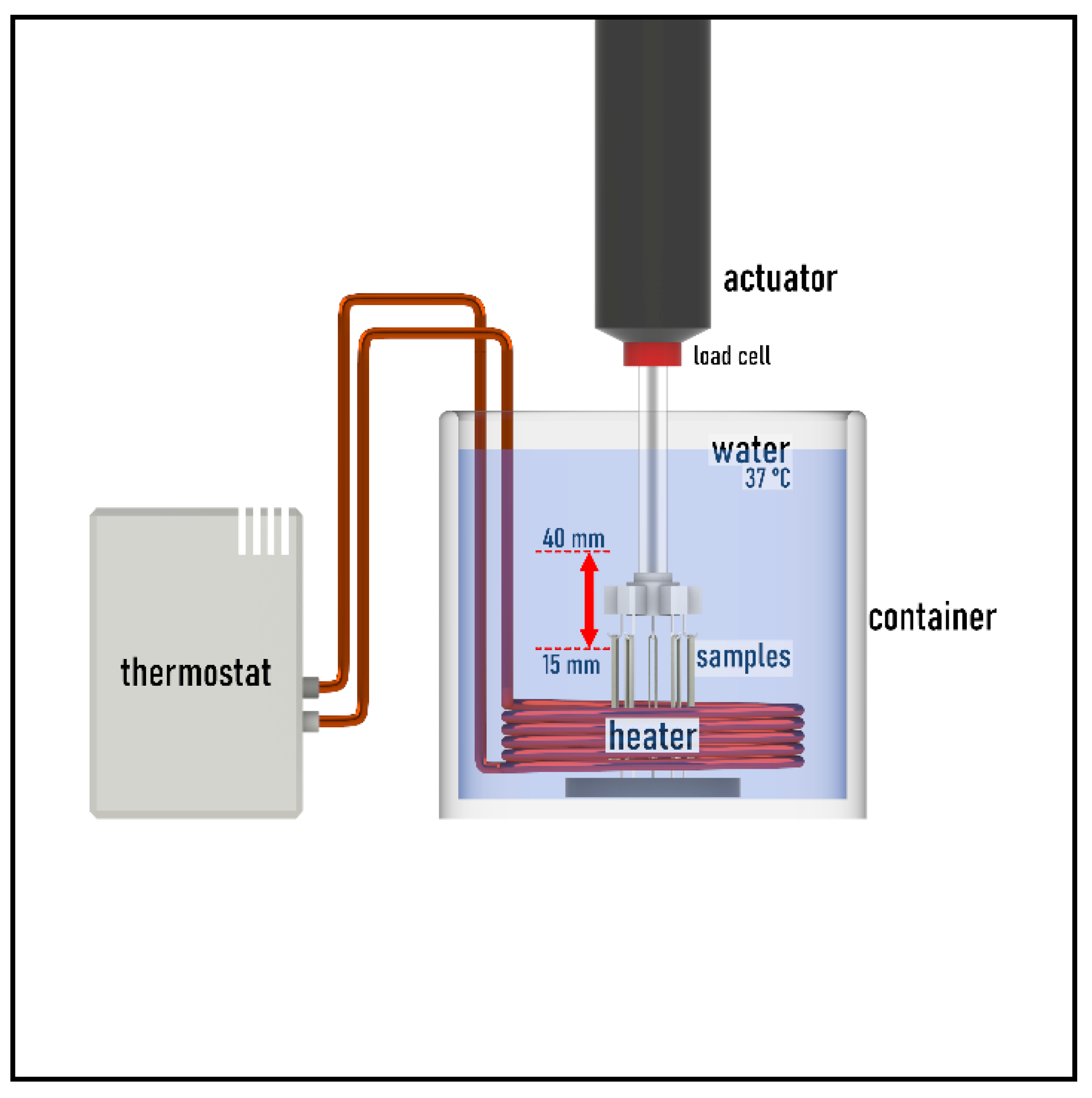
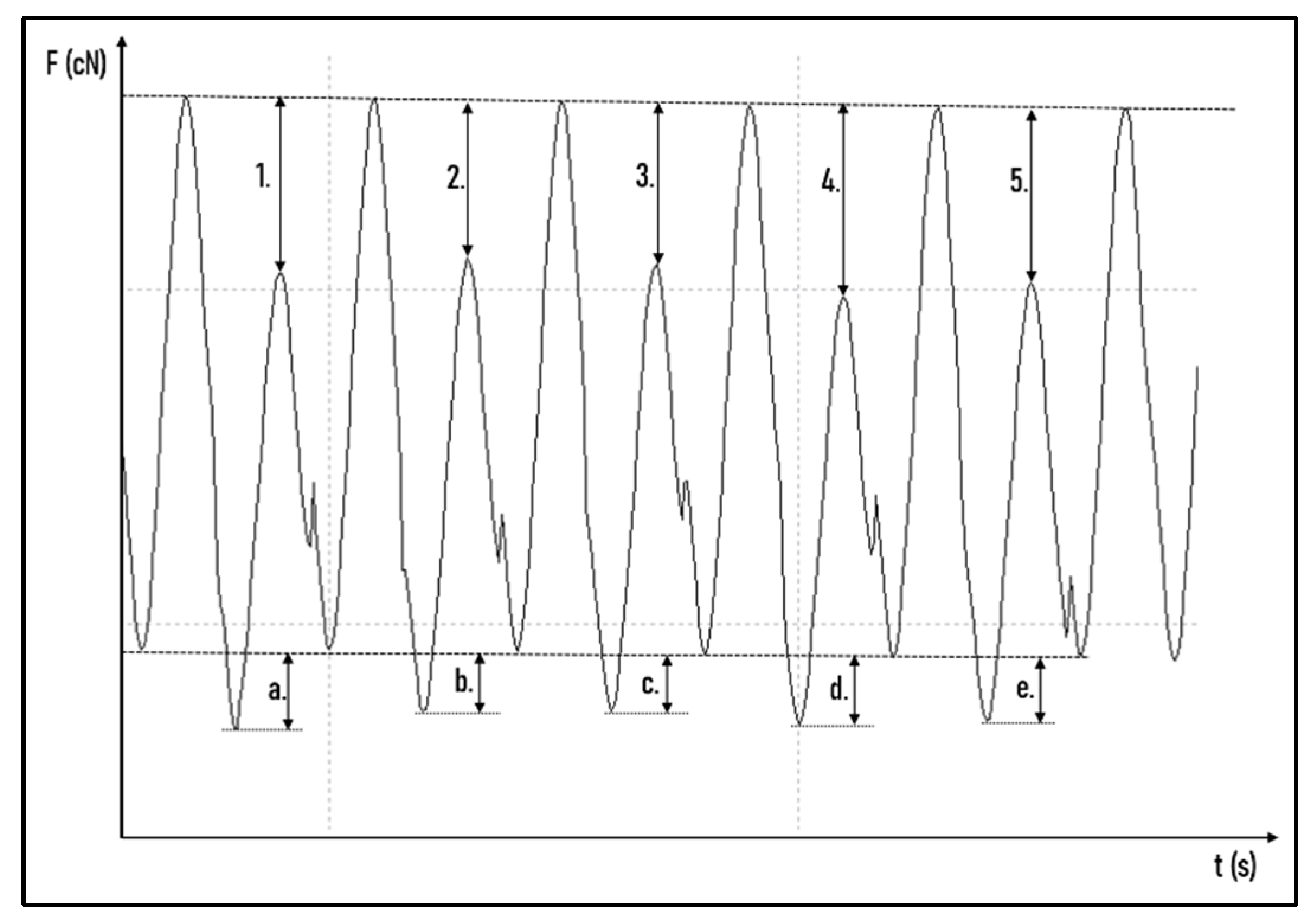





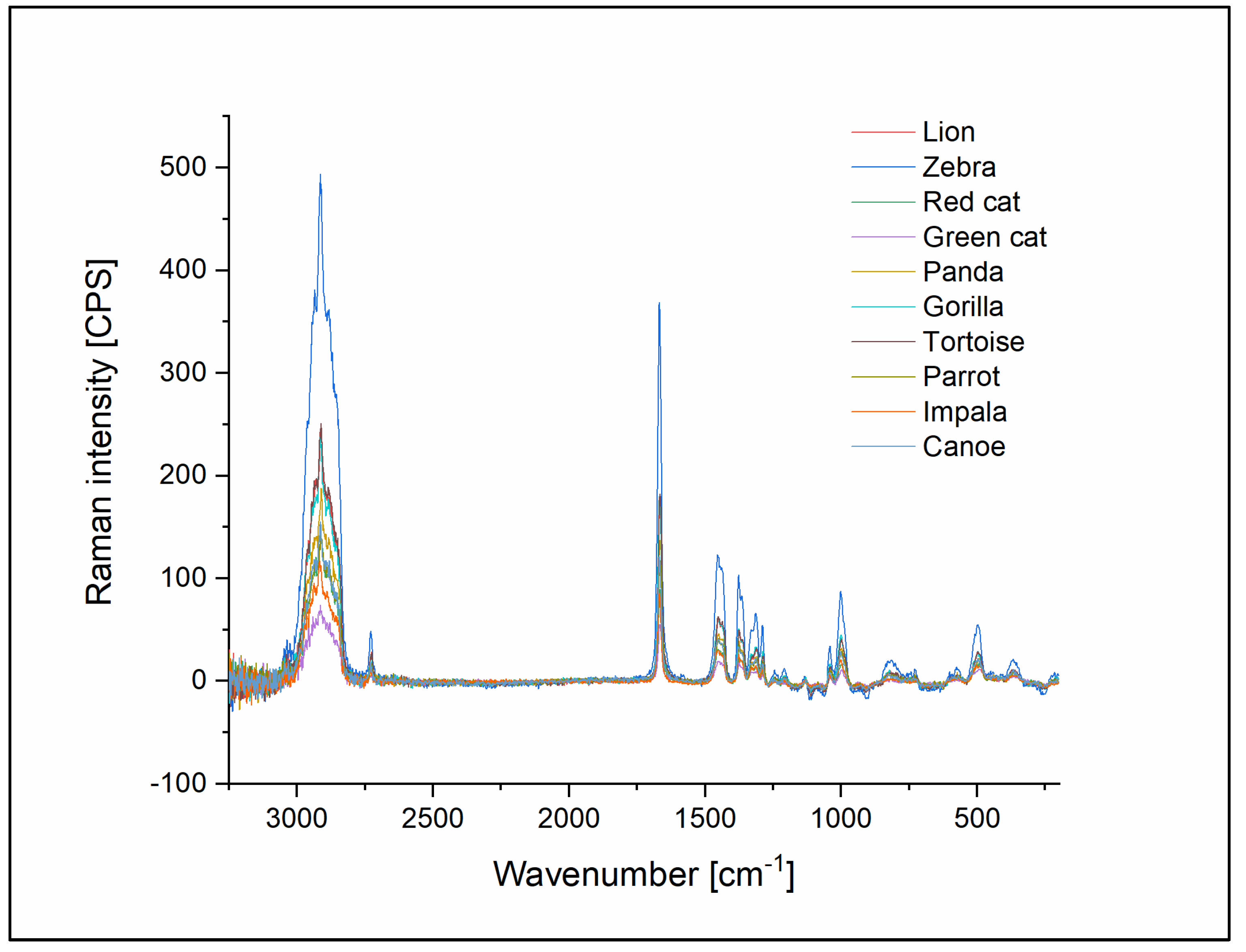
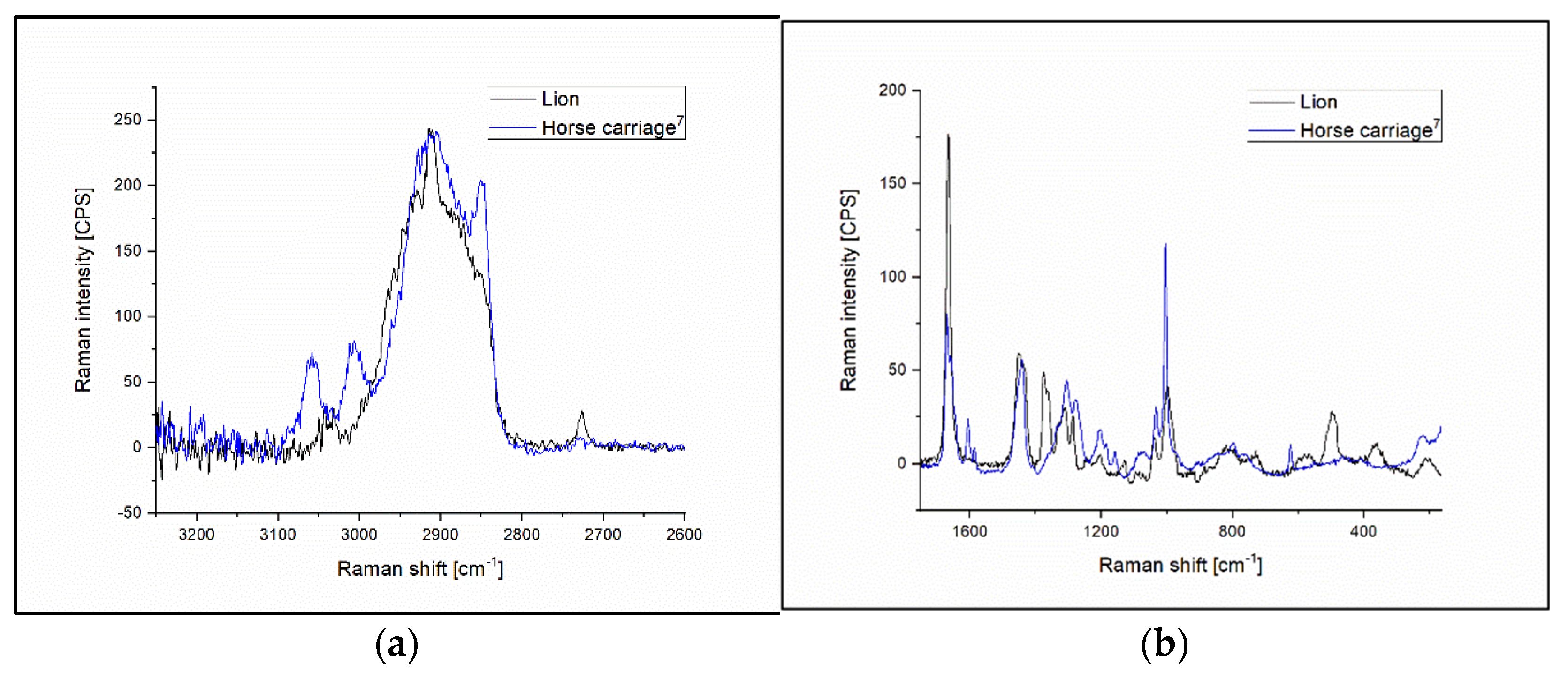
| Manufacturer/Products | Material | Type | Pulling Force | Inner ø[mm] | ReferenceNumber | |
|---|---|---|---|---|---|---|
| 1 | Ortho/Smile safari | Latex | Lion | Medium | 6.4 | LOT 990605 |
| 2 | Zebra | Medium | 4.8 | LOT 990572 | ||
| 3 | Leone | Latex | Red cat | Medium | 6.4 | K0908-04 |
| 4 | Green cat | Medium | 4.8 | K0907-04 | ||
| 5 | AO | Latex | Panda | Medium | 7.9 | LOT 079434 |
| 6 | Gorilla | Medium | 4.8 | REF 000-111C | ||
| 7 | Tortoise | Heavy | 4.8 | LOT 011137 | ||
| 8 | Ormco | Latex | Parrot | Light | 7.8 | LOT 012013216 |
| 9 | Impala | Extra heavy | 4.8 | LOT 121971796 | ||
| 10 | Dentaurum | Latex free | Horse carrige7 | Medium | 4.8 | REF 772-314-01 |
| 11 | Train8 | Medium | 6.4 | REF 772-316-01 | ||
| 12 | Airplane12 | Strong | 4.8 | REF 772-324-01 | ||
| 13 | Space shuttle13 | Strong | 6.4 | REF 772-325-00 | ||
| 14 | RMO | Latex | Canoe | Heavy | 4.8 | REF J01121 |
| No. | Type | Fmax[cN] | SD[cN] | Em[mm] | SD [mm] | Em[%] | SD[%] |
|---|---|---|---|---|---|---|---|
| 1 | Lion | 4667 | 636 | 177 | 1.32 | 879.7 | 28.9 |
| 2 | Zebra | 4680 | 141 | 136 | 2.25 | 904.6 | 14.9 |
| 3 | Red cat | 3228 | 238 | 177 | 3.28 | 882.1 | 16.3 |
| 4 | Green cat | 2801 | 400 | 132 | 2.73 | 875.6 | 18.1 |
| 5 | Panda | 3787 | 254 | 206 | 5.18 | 830.0 | 20.9 |
| 6 | Gorilla | 3265 | 608 | 130 | 3.83 | 858.7 | 25.4 |
| 7 | Tortoise | 3487 | 209 | 128 | 1.68 | 845.7 | 11.1 |
| 8 | Parrot | 1596 | 107 | 204 | 5.06 | 822.6 | 20.4 |
| 9 | Impala | 4078 | 203 | 128 | 1.32 | 845.8 | 8.8 |
| 10 | Horse carriage7 | 3373 | 152 | 219 | 3.49 | 1 450 | 23.1 |
| 11 | Train8 | 2930 | 122 | 252 | 3.73 | 1 252 | 18.5 |
| 12 | Airplane12 | 3349 | 268 | 199 | 4.90 | 1 322 | 32.5 |
| 13 | Space shuttle13 | 3466 | 177 | 228 | 5.19 | 1 133 | 25.8 |
| 14 | Canoe | 2873 | 272 | 134 | 3.04 | 887.6 | 20.2 |
| Cyclic Tensile Fatigue Test | ||||||||
|---|---|---|---|---|---|---|---|---|
| 6. Gorilla | 8. Parrot | |||||||
| 40 mm | 15 mm | 40 mm | 15 mm | |||||
| Mean Diff. [cN] | p | Mean Diff. [cN] | p | Mean Diff. [cN] | p | Mean Diff. [cN] | p | |
| 1 h 0 h | −11.3 | 0.91 | −5.78 | 0.95 | −12.92 | 0.034 | −9.098 | 0.27 |
| 3 h 0 h | −22.22 | 0.37 | −16.20 | 0.18 | −7.98667 | 0.295 | −1.08 | 0.98 |
| 3 h 1 h | −10.92 | 0.92 | −10.42 | 0.63 | 4.93333 | 0.61 | 8.02 | 0.45 |
| 6 h 0 h | −30.32 | 0.1 | −21.44 | 0.037 | --- | --- | --- | --- |
| 6 h 1 h | −19.02 | 0.53 | −15.66 | 0.21 | --- | --- | --- | --- |
| 6 h 3 h | −8.1 | 0.98 | −5.24 | 0.97 | --- | --- | --- | --- |
| 12 h 0 h | −29.94 | 0.11 | −21.44 | 0.037 | --- | --- | --- | --- |
| 12 h 1 h | −18.64 | 0.56 | −15.66 | 0.21 | --- | --- | --- | --- |
| 12 h 3 h | −7.72 | 0.98 | −5.24 | 0.97 | --- | --- | --- | --- |
| 12 h 6 h | 0.38 | 1 | 0.00 | 1 | --- | --- | --- | --- |
| 24 h 0 h | −47.22 | 0.003 | −29.90 | 0.002 | --- | --- | --- | --- |
| 24 h 1 h | −35.92 | 0.036 | −24.12 | 0.015 | --- | --- | --- | --- |
| 24 h 3 h | −25 | 0.25 | −13.70 | 0.34 | --- | --- | --- | --- |
| 24 h 6 h | −16.9 | 0.65 | −8.46 | 0.79 | --- | --- | --- | --- |
| 24 h 12 h | −17.28 | 0.63 | −8.46 | 0.79 | --- | --- | --- | --- |
| Cyclic Tensile Fatigue Test | ||||||||
|---|---|---|---|---|---|---|---|---|
| 11. Train8 | 12. Airplane12 | |||||||
| 40 mm | 15 mm | 40 mm | 15 mm | |||||
| Mean Diff. [cN] | p | Mean Diff. [cN] | p | Mean Diff. [cN] | p | Mean Diff. [cN] | p | |
| 1 h 0 h | −16.14 | 7.54 × 10−6 | −13.64 | 0.043 | −27.88 | 0.26 | −16.56 | 0.16 |
| 3 h 0 h | −30.14 | 0 | −26.66 | 1.61 × 10−4 | −53.46 | 0.021 | −34.08 | 0.0043 |
| 3 h 1 h | −14.0 | 4.27 × 10−5 | −13.02 | 0.055 | −25.58 | 0.32 | −17.52 | 0.14 |
| 6 h 0 h | −39.72 | 0 | −35.48 | 5.42 × 10−6 | --- | --- | --- | --- |
| 6 h 1 h | −23.58 | 0 | −21.84 | 1.23 x 10−3 | --- | --- | --- | --- |
| 6 h 3 h | −9.58 | 0.002 | −8.82 | 0.27 | --- | --- | --- | --- |
| Comparison of the Cyclic Fatigue and Force Relaxation Test | ||||||||||||
|---|---|---|---|---|---|---|---|---|---|---|---|---|
| 40 mm Length | 15 mm Length | |||||||||||
| 0 h | 12 h | 24 h | 0 h | 12 h | 24 h | |||||||
| Mean Diff. (cN) | p | Mean Diff. (cN) | p | Mean Diff. (cN) | p | Mean Diff. (cN) | p | Mean Diff. (cN) | p | Mean Diff. (cN) | p | |
| 1. Lion | 2.42 | 0.82 | −10.35 | 0.46 | --- | --- | −11.20 | 0.04 | −21.18 | 0.01 | --- | --- |
| 2. Zebra | 5.44 | 0.64 | −11.40 | 0.36 | −45.40 | 0.01 | −25.36 | 0.001 | −60.89 | 4.17 × 10−4 | −65.85 | 8.32 × 10−4 |
| 3. Red cat | 7.06 | 0.67 | −25.30 | 0.15 | 1.90 | 0.91 | −12.34 | 0.04 | −21.24 | 0.03 | −31.84 | 9.24 × 10−5 |
| 4. Green cat | 0.92 | 0.96 | 15.32 | 0.45 | 31.00 | 0.23 | −26.72 | 0.009 | −24.86 | 0.01 | −11.89 | 0.33 |
| 5. Panda | −5.68 | 0.31 | --- | --- | --- | --- | 0.61 | --- | --- | --- | --- | |
| 6. Gorilla | 25.72 | 0.19 | 21.58 | 0.09 | 15.70 | 0.21 | −11.46 | 0.67 | −24.50 | 0.06 | −22.16 | 0.33 |
| 7. Tortoise | 5.48 | 0.66 | --- | --- | --- | --- | −48.20 | 3.80 × 10−4 | --- | --- | --- | --- |
| 8. Parrot | 26.02 | 0.001 | --- | --- | --- | --- | 5.42 | 0.12 | --- | --- | --- | --- |
| 9. Impala | 1.06 | 0.96 | 19.56 | 0.29 | 0.08 | 1.00 | −44.90 | 2.79 × 10−04 | −36.48 | 0.002 | −43.77 | 0.01 |
| 10. Horse carriage7 | −1.44 | 0.86 | --- | --- | --- | --- | −43.60 | 9.02 × 10−5 | --- | --- | --- | --- |
| 11. Train8 | 7.82 | 0.63 | --- | --- | --- | --- | −36.20 | 2.90 × 10−4 | --- | --- | --- | --- |
| 12. Airplane12 | 16.50 | 0.35 | --- | --- | --- | --- | −72.46 | 4.23 × 10−5 | --- | --- | --- | --- |
| 13. Space shuttle13 | 21.24 | 7.32 × 10−4 | --- | --- | --- | --- | −66.32 | 4.66 × 10−8 | --- | --- | --- | --- |
| 14. Canoe | 27.42 | 0.01 | 21.68 | 0.03 | 8.95 | 0.43 | −30.56 | 4.59 × 10−5 | −18.12 | 0.002 | −24.69 | 0.003 |
| Latex-free ligatures | ||||||||||||
| Latex ligatures | ||||||||||||
Publisher’s Note: MDPI stays neutral with regard to jurisdictional claims in published maps and institutional affiliations. |
© 2022 by the authors. Licensee MDPI, Basel, Switzerland. This article is an open access article distributed under the terms and conditions of the Creative Commons Attribution (CC BY) license (https://creativecommons.org/licenses/by/4.0/).
Share and Cite
Gurdán, Z.; Turzó, K.; Lőrinc, L.; Szabó, P.; Karádi, K.; Lukács, A.; Told, R.; Kardos, K.; Maróti, P. Mechanical Characterization and Structural Analysis of Latex-Containing and Latex-Free Intermaxillary Orthodontic Elastics. Polymers 2022, 14, 4488. https://doi.org/10.3390/polym14214488
Gurdán Z, Turzó K, Lőrinc L, Szabó P, Karádi K, Lukács A, Told R, Kardos K, Maróti P. Mechanical Characterization and Structural Analysis of Latex-Containing and Latex-Free Intermaxillary Orthodontic Elastics. Polymers. 2022; 14(21):4488. https://doi.org/10.3390/polym14214488
Chicago/Turabian StyleGurdán, Zsuzsanna, Kinga Turzó, Laura Lőrinc, Péter Szabó, Kristóf Karádi, András Lukács, Roland Told, Kinga Kardos, and Péter Maróti. 2022. "Mechanical Characterization and Structural Analysis of Latex-Containing and Latex-Free Intermaxillary Orthodontic Elastics" Polymers 14, no. 21: 4488. https://doi.org/10.3390/polym14214488
APA StyleGurdán, Z., Turzó, K., Lőrinc, L., Szabó, P., Karádi, K., Lukács, A., Told, R., Kardos, K., & Maróti, P. (2022). Mechanical Characterization and Structural Analysis of Latex-Containing and Latex-Free Intermaxillary Orthodontic Elastics. Polymers, 14(21), 4488. https://doi.org/10.3390/polym14214488










